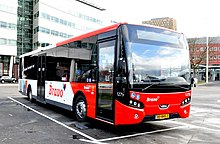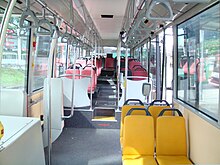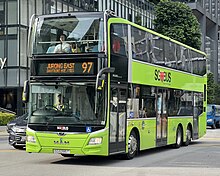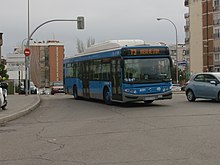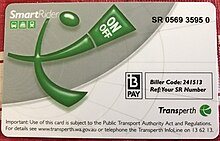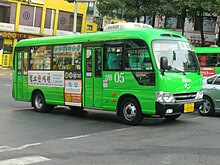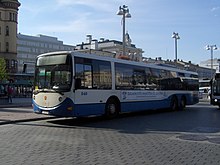
A bus is a road vehicle that carries significantly more passengers than an average car or van, but less than the average rail transport. It is most commonly used in public transport, but is also in use for charter purposes, or through private ownership. Although the average bus carries between 30 and 100 passengers, some buses have a capacity of up to 300 passengers. The most common type is the single-deck rigid bus, with double-decker and articulated buses carrying larger loads, and midibuses and minibuses carrying smaller loads. Coaches are used for longer-distance services. Many types of buses, such as city transit buses and inter-city coaches, charge a fare. Other types, such as elementary or secondary school buses or shuttle buses within a post-secondary education campus, are free. In many jurisdictions, bus drivers require a special large vehicle licence above and beyond a regular driving licence.

Hong Kong has a highly developed transport network, encompassing both public and private transport. Based on Hong Kong Government's Travel Characteristics Survey, over 90% of daily journeys are on public transport, the highest rate in the world. However, in 2014 the Transport Advisory Committee, which advises the Government on transportation issues, issued a report on the much-worsened congestion problem in Hong Kong and pointed at the excessive growth of private cars during the past 10–15 years.
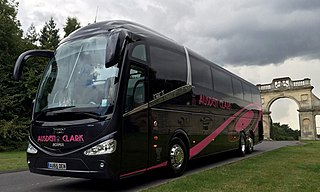
A coach is a type of bus built for longer-distance service, in contrast to transit buses that are typically used within a single metropolitan region. Often used for touring, intercity, and international bus service, coaches are also used for private charter for various purposes. Coaches are also related and fall under a specific category/type of RVs.
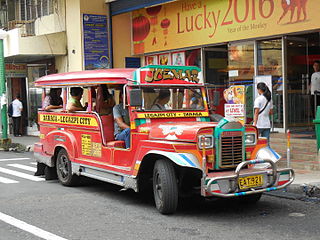
A share taxi is a mode of transport which falls between a taxicab and a bus. These vehicles for hire are typically smaller than buses and usually take passengers on a fixed or semi-fixed route without timetables, but instead departing when all seats are filled. They may stop anywhere to pick up or drop off their passengers. Often found in developing countries, the vehicles used as share taxis range from four-seat cars to minibuses. They are often owner-operated.
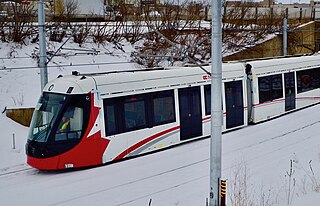
OC Transpo is the organisation that operates and plans public transport in the city of Ottawa. OC Transpo's system includes bus rapid transit, light rail, conventional bus routes, and door-to-door paratransit.

A double-decker bus or double-deck bus is a bus that has two storeys or decks. Double-deckers are primarily for commuter transport, but open-top models are used as sight-seeing buses for tourists, and there are coaches too for long-distance travel. They appear in many places around the world but are presently most commonly used as mass transport in cities of Britain and Ireland, in Hong Kong, and in Singapore.

An articulated bus, also referred to as a slinky bus, bendy bus, tandem bus, vestibule bus, stretch bus, or an accordion bus, is an articulated vehicle, typically a motor bus or trolleybus, used in public transportation. It is usually a single-decker, and comprises two or more rigid sections linked by a pivoting joint (articulation) enclosed by protective bellows inside and outside and a cover plate on the floor. This allows a longer legal length than rigid-bodied buses, and hence a higher passenger capacity (94–120), while still allowing the bus to maneuver adequately.

A minibus, microbus, or minicoach is a passenger-carrying motor vehicle that is designed to carry more people than a multi-purpose vehicle or minivan, but fewer people than a full-size bus. In the United Kingdom, the word "minibus" is used to describe any full-sized passenger-carrying van or panel truck. Minibuses have a seating capacity of between 12 and 30. Larger minibuses may be called midibuses. Minibuses are typically front engine step-in vehicles, although low floor minibuses are particularly common in Japan.

A low-floor bus is a bus or trolleybus that has no steps between the ground and the floor of the bus at one or more entrances, and low floor for part or all of the passenger cabin. A bus with a partial low floor may also be referred to as a low-entry bus or seldom a flat-floor bus in some locations.
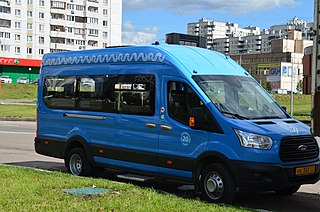
Marshrutnoye taksi, commonly known by the colloquialism Marshrutka, are share taxis found in Eastern Europe and the republics of the former Soviet Union. Usually vans, they drive along set routes, depart only when all seats are filled, and may have higher fares than buses. Passengers can board a marshrutka anywhere along its route if there are seats available.

Transjakarta or Jakarta BRT is a bus rapid transit (BRT) system in Jakarta, Indonesia. The first BRT system in Southeast Asia, it commenced operations on 15 January 2004 to provide a fast public transport system to help reduce rush hour traffic. The system is considered as the first revolutionary public transit mode in the capital city of Indonesia. The buses run in dedicated lanes (busways), and ticket prices are subsidised by the regional government. Transjakarta has the world's longest BRT system, which operates about 4,300 buses. Transjakarta aims to have 50 percent of its fleet be electric buses by 2027. By 2030, the aim is for the entire Transjakarta ecosystem to use electric buses. As of November 2023, it serves an average of 1.134 million passengers daily.

A bus conductor is a person responsible for collecting fares from bus passengers. Bus conductors may also be responsible for helping passengers to board, keeping the bus route on schedule, attracting potential passengers to the vehicle, and announcing bus stops.
Bus services in Hong Kong have a long history. As of 2023, four companies operate franchised public bus services. There are also a variety of non-franchised public bus services, including feeder bus services to railway stations operated by MTR, and residents' services for residential estates.
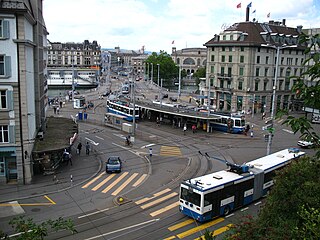
Verkehrsbetriebe Zürich (VBZ) is a public transport operator in the Swiss city of Zürich, and is wholly owned by the city. Previously known as the Städtische Strassenbahn Zürich (StStZ), the organisation was founded in 1896 and adopted its current name in 1950.

A single-decker bus or single-decker is a bus that has a single deck for passengers. Normally the use of the term single-decker refers to a standard two-axled rigid bus, in direct contrast to the use of the term double-decker bus, which is essentially a bus with two passenger decks and a staircase. These types of single-deckers may feature one or more doors, and varying internal combustion engine positions. The majority of single-deckers have a length of up to 12 metres, although some exceptions of longer buses exist. They also typically weigh between 11 and 14 tons.

In public transport in the United Kingdom and Australia, hail and ride is boarding or alighting a mode of public transport by signalling the driver or conductor that one wishes to board or alight, rather than the more conventional system of using a designated stop. Hail and ride is used primarily in bus transport. The act of requesting a hackney carriage to stop is also termed 'hailing'.

Public transport bus services are generally based on regular operation of transit buses along a route calling at agreed bus stops according to a published public transport timetable.
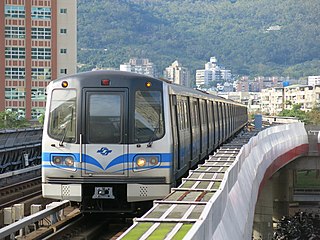
Public transport is a system of transport for passengers by group travel systems available for use by the general public unlike private transport, typically managed on a schedule, operated on established routes, and that may charge a posted fee for each trip. There is no rigid definition of which kinds of transport are included, and air travel is often not thought of when discussing public transport—dictionaries use wording like "buses, trains, etc." Examples of public transport include city buses, trolleybuses, trams and passenger trains, rapid transit and ferries. Public transport between cities is dominated by airlines, coaches, and intercity rail. High-speed rail networks are being developed in many parts of the world.

The public light bus (PLB) or minibus is a public transport service in Hong Kong. It uses minibuses to provide quicker transport and to serve areas that standard Hong Kong bus lines cannot reach as efficiently. The vehicles are colloquially known by the code-switch Van仔.

Simcoe County LINX is a public transport service managed by Simcoe County and operated by First Student Canada, which is responsible for inter-community regional bus service throughout Simcoe County, connecting rural towns and townships to cities in the county such as Barrie and Orillia. Service began in 2018 with a single trial route, operating with a mixed fleet of low-floor midibuses and accessible paratransit vehicles. In August 2019, service was expanded to four routes, five routes in 2020 and six routes in August 2021.
